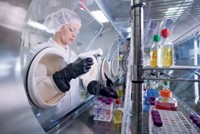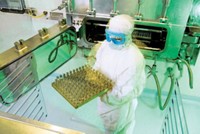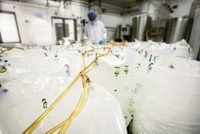Advertisement
Grab your lab coat. Let's get started
Welcome!
Welcome!
Create an account below to get 6 C&EN articles per month, receive newsletters and more - all free.
It seems this is your first time logging in online. Please enter the following information to continue.
As an ACS member you automatically get access to this site. All we need is few more details to create your reading experience.
Not you? Sign in with a different account.
Not you? Sign in with a different account.
ERROR 1
ERROR 1
ERROR 2
ERROR 2
ERROR 2
ERROR 2
ERROR 2
Password and Confirm password must match.
If you have an ACS member number, please enter it here so we can link this account to your membership. (optional)
ERROR 2
ACS values your privacy. By submitting your information, you are gaining access to C&EN and subscribing to our weekly newsletter. We use the information you provide to make your reading experience better, and we will never sell your data to third party members.
Business
Outfitting The Full Disposable Kit
Providers of single-use bioreactors seek to expand flexibility while keeping costs low
by Ann M. Thayer
December 13, 2010
| A version of this story appeared in
Volume 88, Issue 50

In the market for disposable bioprocess reactors, flexibility refers to more than the plastic of the cell culture bag. As the technology has matured and become accepted, many users want increasingly sophisticated, even customized, single-use systems. Suppliers are working to meet these needs, often through partnerships with other technology providers. At the same time, they are trying to maintain the cost benefits of disposable systems.
The global market for single-use bioreactor systems is roughly $400 million per year and growing by up to 20% annually, according to some industry insiders. Lower capital and operating costs compared with stainless steel reactors have helped single-use systems penetrate about 30–40% of the bioprocessing market.
Developers of biologic drugs often prefer these more flexible and faster-to-use fermentation vessels over conventional ones because they can help meet compressed timelines or delay big investments in unapproved products. With even broader adoption anticipated across multiple bioprocess steps and at different scales, suppliers expect to see disposable technologies become the standard approach within 10 years.
“Eight years ago, most people didn’t believe you could replace a stainless steel vessel with a bag,” says Jeffrey Craig, global director of marketing and business development at Danbury, Conn.-based ATMI LifeSciences, the bioprocessing arm of the specialty materials firm ATMI. “We’re past that stage. The technologies have proven themselves as cost-efficient, technically comparable, and economically and operationally valuable.”
In a recent review of available systems, Zurich University of Applied Sciences researchers concluded that the needs of drug and vaccine makers have driven the trend toward single-use systems (Appl. Microbiol. Biotechnol., DOI: 10.1007/s00253-009-2422-9). Stirred disposable reactors, at volumes up to 1,000 L, are the most common, despite having been on the market only since 2006.
Meanwhile, technological changes have taken place over the past decade to turn simple medical-grade polymer bags used for cell culture storage and transport into fully outfitted bioreactors. Used in lab, development, clinical, and even production operations, the units also can be integrated to make “disposable factories,” Craig says.
Craig calls the newer bioreactors “smart bags” to distinguish them from storage containers. The first step in this direction was the addition of mixing technology, he explains. Although many competitors use mechanical rocking or shaking, ATMI focuses on disposable plastic paddles, wands, and magnetic and levitated impellers within the bags.
Later advances added ports and connectors. “Smart bags mean that you put in probes for measuring oxygen retention, carbon dioxide levels, and temperature, and start controlling the environment and automatically adjusting the process inside the bag,” Craig says. Bags also must couple to other operations, such as downstream purification steps, in a way that is compliant with Good Manufacturing Practices (GMP).
In this way, ATMI’s Nucleo Bioreactor was designed as an alternative to stainless steel reactors. Available in volumes up to 600 L, the multiport unit is scalable and customizable. It was created jointly by ATMI, which makes the polymer film bags and disposable mixers; the French firm Pierre Guérin Technologies, which designs reactors and control systems; and Belgium’s Artelis, which specializes in cell culture processing and was acquired by ATMI last month.
Most of the major players in the single-use bioreactor arena have been built through acquisitions. Leading providers include Sartorius Stedim Biotech (SSB) and Thermo Fisher Scientific. Before merging with Thermo in 2006, Fisher Scientific acquired Utah-based HyClone. Similarly, in 2007, GE Healthcare acquired Wave Biotech in the U.S. to build its bioprocess division (C&EN, June 4, 2007, page 20).
In 2008, Germany’s SSB acquired Swiss Wave Biotech AG, which at one time was a sister company to the firm that GE bought. Prior to that SSB had gained a foothold in the field by acquiring France’s Stedim Biosystems in 2007. Today, SSB leads the market in Europe and in Asia and is among the top suppliers in the U.S., says Christel Fenge, the firm’s vice president of marketing for fermentation technologies.
Collaborations with external technology providers are important to the business, Fenge adds. SSB is working with ExcellGene to develop orbitally shaken bioreactors and with Bayer Technology Services for oscillating bioreactors. The company offers differently agitated versions of its single-use Biostat Cultibag reactors in sizes up to 1,000 L.
It also distributes ATMI’s magnetic and levitated mixing technology and has a license to use it with its own bags. “We collaborate with companies on process analytical technology solutions—both sensors and software for data acquisition, data mining, and design of experiment,” Fenge says. “And we work with our customers to provide solutions that are suitable for them but that are also somewhat generic or standardized to the application.”
SSB and others are working to increase cell densities, possibly through cell retention devices. Disposable bioreactors of a few hundred liters have become popular for making clinical-scale materials, and “it is now possible to consider commercial manufacturing in a single-use bioreactor,” Fenge says. Here, reactors at 1,000 L or above hold promise, although the size may drop if cell densities can be increased. According to the Zurich University scientists, Xcellerex was the first to offer a 2,000-L disposable bioreactor. The Marlborough, Mass.-based company links its XDR units to make what it calls a FlexFactory.
ATMI’s acquisition of Artelis brought it expertise in high cell-density technologies. “The limitation of these single-use technologies is that you can’t build a 20,000-L bag, but you can build a 2,000-L one,” Craig points out. “Our sweet spot, where all the advantages become significant, is at smaller scale.” Luckily, he adds, the drug industry is moving away from blockbusters to drugs that require smaller-scale production.
The move toward producing clinical or commercial drugs in single-use systems has brought out some customer concerns. A call for security of supply, because without it a customer might be reactorless, is being answered by larger, more robust suppliers. SSB, for example, produces its bags at sites in France, Tunisia, Switzerland, and California, and it has long-term supply agreements with film and resin producers.
ATMI expanded its Bloomington, Minn., facility this year to mirror one in Hoegaarden, Belgium. At both, it produces its own multilaminate films and makes the bags under clean room conditions. ATMI and joint-venture partner Austar International recently opened a facility in Beijing. Although the site currently makes packaging materials, Craig anticipates a need in the near future for making bioreactor bags.
Drug companies are also concerned about how bioreactor materials other than the familiar stainless steel might impact their processes. Incorporating just one film type in interconnected products reduces the time and cost of GMP validation across process steps and in scaling up, according to ATMI. Suppliers also point out that repeated cleaning and sterilization of vessels is no longer required with disposables.
Another materials-related issue for end users and regulators pertains to extractables and leachables from the polymer bags. Much thought is being given around testing to determine the potential for contamination under different processing conditions. The Bio-Process Systems Alliance (BPSA), a trade group that became affiliated in late 2009 with the Society of Chemical Manufacturers & Affiliates, is addressing concerns while promoting single-use systems.
Although experience is growing, the single-use technologies must compete on economics and performance against existing investments in stainless steel. BPSA has published an implementation road map as well as guides on disposal, quality testing, and the technology’s market impact. Disposal, usually incineration, is just one question in ongoing life-cycle studies of the bags’ environmental footprint.
Industry standards do not exist for single-use systems, according to BPSA. They likely would help the biopharmaceutical industry as it shifts technologies and suppliers as they try to keep bioreactors flexible yet economical. “Everybody customizes their bags, but then industry standards become a nightmare,” Craig says. “We are trying now to bring industry back to some standards that will also reduce costs.”





Join the conversation
Contact the reporter
Submit a Letter to the Editor for publication
Engage with us on Twitter